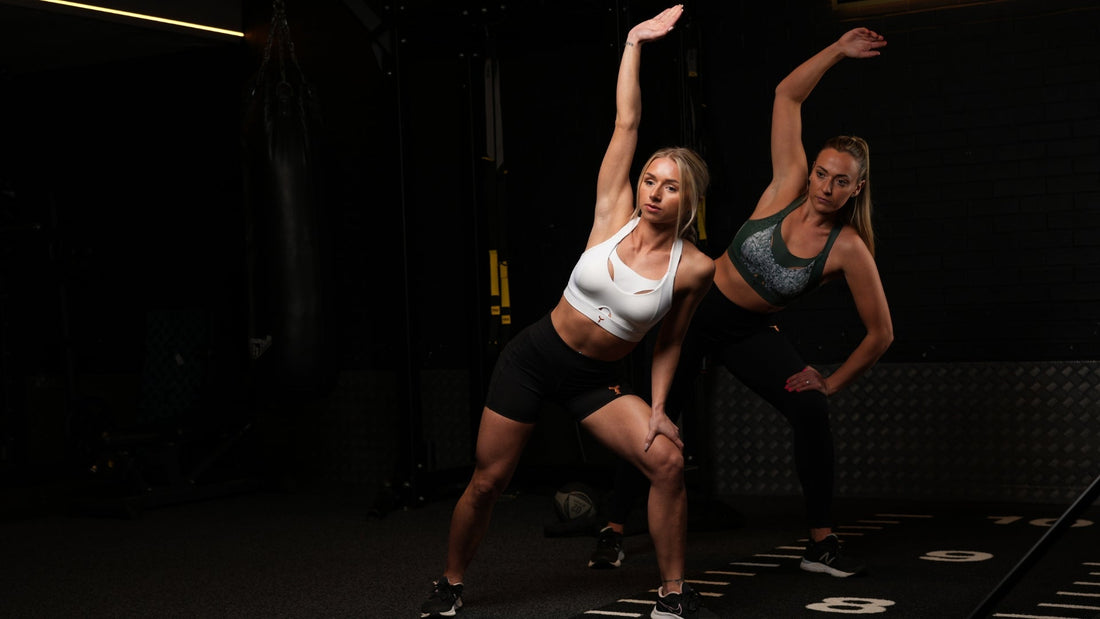If you're looking to get a new sports bra and want to know what makes a great one, check out our guide. Using the latest in breast health and bra science research from experts like The Bra Professor, we created a comprehensive guide to help you make an informed choice.
Why is proper breast support so important?
Breasts don't just move up and down; they also move forward, backward, side to side, and in a figure 8 motion (see below). 
Breast movement trajectories of body (solid line) and breast (dotted line) with sports bra in one stride of running in the medial/lateral direction.
“With movement up to 21 cm (about 8.27 in) and acceleration faster than a Formula 1 car, excessive breast movement has the potential to cause damage to breast tissue. We have recorded breast skin stretching to more than double its original length if not properly supported.” -Prof. Joanna Wakefield-Scurr, founder of Research Group in Breast Health at the University of Portsmouth
Does breast movement affect performance?
A study found that 50% of women said their breasts negatively impacted their participation in sports with some claiming it has caused them to drop out of sports altogether.
Breast movement has been linked to an increase in muscle activity which ultimately means you fatigue sooner. It’s been found that torso, pelvis and arm movement increases, along with your breathing frequency. It has also been reported that breast movement changes the way women move and causes your running stride to shorten by up to 4 cm, which over a marathon means you run an extra mile (The Bra Professor, n.d.).
What are some critical aspects of a great sports bra?
1) The Underband
The underband is crucial as it provides 80% of the support. If the underband is stretchy enough to get past your shoulders when pulled over your head, it means it’s not supportive enough. The band must be firm enough to hold your breasts up without other support while still allowing you to take full breaths and move comfortably.
Instead, look for a sports bra with a firm but not tight underband that is adjustable.
FACT: An underband that’s too tight can cause rib cage pain (Dr. James D. Namnoum, n.d.)
2) Shoulder Straps
Shoulder straps have long been the dread of bra wearers and for good reason. Narrow or overly tight straps, which are all too common, cause pain, blisters, migraines and even nerve damage leading to finger and hand numbness. Whereas straps that are too loose provide less support and can lead to increased breast movement.
It is best to choose a sports bra, and even a daily wear bra, with wide and padded shoulder straps to reduce pressure on the neck and shoulders (Morris & McClelland, 2019). It is recommended to select a sports bra with adjustable straps to ensure a proper fit. This also comes into play during a woman’s menstrual cycle or pregnancy as breast size can change. Learn more about this topic, here.
3) The Style
There are three styles of sports bras: compression, encapsulation and combination.
The way a sports bra holds your breasts in, plays a massive role in how supportive and comfortable it is.
Compression sports bras are designed to minimize breast movement by pressing the breasts down firmly towards your chest wall. While this reduces movement, it often comes at a cost to the wearer. Pure compression bras can be excessively tight, hindering the ability to take deep breaths, increasing back and rib pain, digging in that leads to migraines and ultimately decreasing performance.
Encapsulation sports bras separate the breasts into moulded cups for individual support, but they often fall short during high-impact activities. Without adequate compression, the breasts can move within the cups, leading to chafing and tissue stretching.
A combination sports bra offers the best of both worlds and is recommended for women engaging in intense activity. This style provides individual breast support while reducing breast movement and is often the most comfortable and supportive choice. Choosing the right combination sports bra is crucial, as some brands still make them with too much compression, leading to pain.
4) Go Wire-free
Underwire has been proven useless for support and only serves the purpose of shaping the breast. A 2021 study suggests that wired bras cause more rubbing, chafing and discomfort than non-wired bras (Campbell & Kane, 2021). It's time to ditch the painful stabbing metal!
How do I know it fits correctly?
Did you know (Arnot et al.,2008) found that 80% of women wear an ill-fitting bra? Follow these expert guidelines by the Bra Professor and Laura Tempesta at Bravolution to ensure you don’t become a statistic.
The Underband
If the underband is too big, it will sag and create a ‘frown’ shape on your body. If it's too small, it will pinch your back, causing your skin to wrinkle or mound. A well-fitting underband should be snug and lay straight, providing firm support all around your body.
Cups
Your breasts should fit comfortably within the cups, without bulging as shown below. If your breasts spill over the top or sides, the cup is too small. Additionally, a gap between the bra and your breasts indicates that the cups may be too large.
Straps
The straps are too tight if they hurt your shoulders and leave red marks or indentations. If they fall off your shoulders, they are too loose.
If you're looking for a sports bra that meets all your needs and supports your health and workouts, check out the Tigers Eye sports bra. Created with science and guidance from breast health experts like The Bra Professor, it has outperformed 60 top competitors in its' test group for support and comfort. Plus, it has unique features that traditional sports bras lack, that add to its performance, such as “The Vault”.





Leave a comment